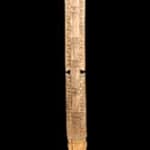Giryama Wooden Kigango Funerary Post, 19th Century CE - 20th Century CE
Wood
68
PF.6134
Further images
When the spirit of the deceased appears in the dreams of the living and complains about the lack of a body, a kigango funerary post is erected. Vigango (plural of...
When the spirit of the deceased appears in the dreams of the living and complains about the lack of a body, a kigango funerary post is erected. Vigango (plural of kigango) are not necessarily grave markers, for they do not mark the physical remains of the deceased. Instead, their role is to provide a new abode, in essence a new body, for the spirit of the deceased. In order to be honored with a kigango, the deceased had to be an important, and wealthy, member of the Giryama tribe.
Apparently, the individual had to be initiated into one of the numerous societies that structure the rules of Giryama society. Some would argue that only members of the gohu society, which is concerned with the consumption and distribution of wealth, are honored with such works. Indeed, membership in the gohu society was in itself a prestigious sign of wealth. Vigango are generally placed inside the men’s conversation hut of a homestead, easily accessible to the elder male of the clan, whose duty it is to pay frequent libations to the spirit of the deceased as represented by the kigango. Libations range from palm wine poured into small coconut shells placed at the base of the work to sacrificed chickens or goats. Animals are only sacrificed to honor a kigango if dreams or misfortune recommend it. The animals are slaughtered nearby the work, allowing the blood to nourish the spirit of the deceased. This kigango is decorated with a characteristic pattern of incised triangle that are sometimes said to represent human ribs.
This work is unusual because the triangular notches carved into the sides, which normally signify the termination of the decorative patterns, here serve as part of the pattern and enhance the overall adornment. The abstracted head is depicted as a two-dimension, flat circle incised with three squares, two for the eyes and one for the mouth. While the hard wood is very durable (one can tell which part of the work rested in the ground), vigango where only venerated so long as the spirit of the deceased remained fresh in the minds of his ancestors. Over time, the memory of the deceased would fade away as generations passed by and the kigango would be neglected, then forgotten when the homestead would be abandoned for brighter pastures.
While the spirit of the deceased may have become comfortable with his lack of a body and vanished from this wooden replacement, this empty shell of a spirit serves as a beautiful memorial to a life cut short. Furthermore, we are able to appreciate this kigango for its whimsical abstraction of the human form, a stunning depiction that is both instantly recognizable and yet aesthetically pleasing. This would be a worthy addition to any African art collection.
Apparently, the individual had to be initiated into one of the numerous societies that structure the rules of Giryama society. Some would argue that only members of the gohu society, which is concerned with the consumption and distribution of wealth, are honored with such works. Indeed, membership in the gohu society was in itself a prestigious sign of wealth. Vigango are generally placed inside the men’s conversation hut of a homestead, easily accessible to the elder male of the clan, whose duty it is to pay frequent libations to the spirit of the deceased as represented by the kigango. Libations range from palm wine poured into small coconut shells placed at the base of the work to sacrificed chickens or goats. Animals are only sacrificed to honor a kigango if dreams or misfortune recommend it. The animals are slaughtered nearby the work, allowing the blood to nourish the spirit of the deceased. This kigango is decorated with a characteristic pattern of incised triangle that are sometimes said to represent human ribs.
This work is unusual because the triangular notches carved into the sides, which normally signify the termination of the decorative patterns, here serve as part of the pattern and enhance the overall adornment. The abstracted head is depicted as a two-dimension, flat circle incised with three squares, two for the eyes and one for the mouth. While the hard wood is very durable (one can tell which part of the work rested in the ground), vigango where only venerated so long as the spirit of the deceased remained fresh in the minds of his ancestors. Over time, the memory of the deceased would fade away as generations passed by and the kigango would be neglected, then forgotten when the homestead would be abandoned for brighter pastures.
While the spirit of the deceased may have become comfortable with his lack of a body and vanished from this wooden replacement, this empty shell of a spirit serves as a beautiful memorial to a life cut short. Furthermore, we are able to appreciate this kigango for its whimsical abstraction of the human form, a stunning depiction that is both instantly recognizable and yet aesthetically pleasing. This would be a worthy addition to any African art collection.







